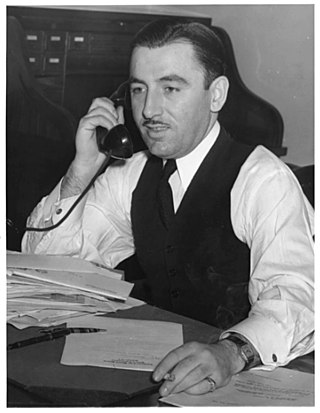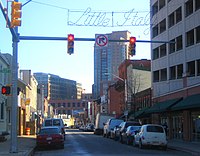
Thomas Ludwig John D'Alesandro Jr. was an American politician who served as the 41st mayor of Baltimore from 1947 to 1959. A member of the Democratic Party, he previously represented Maryland's 3rd congressional district in the United States House of Representatives from 1939 until 1947. He was known for his own political prominence as well as that of his children and was the patriarch of the D'Alesandro political family, which includes Nancy Pelosi, the 52nd speaker of the United States House of Representatives; and Thomas D'Alesandro III, the 44th mayor of Baltimore.

Little Italy is a neighborhood located in southeastern Baltimore, Maryland. The neighborhood is known for its strong Italian-American heritage and identity. The neighborhood is still mostly populated by the descendants of Italian-American immigrants and remains a closely knit ethnic enclave.

Highlandtown is a neighborhood of Baltimore, Maryland, United States.

Thomas Ludwig John D'Alesandro III was an American attorney and politician who served as the 44th mayor of Baltimore from 1967 to 1971. A member of the Democratic Party, he was the president of the Baltimore City Council from 1962 to 1967. During his tenure as mayor, the Baltimore riot of 1968 occurred. He was the eldest son of Thomas D'Alesandro Jr., the 41st mayor of Baltimore; and brother of Nancy Pelosi, the 52nd speaker of the United States House of Representatives, and first woman to hold that office.

Baltimore is the most populous city in the U.S. state of Maryland. With a population of 585,708 at the 2020 census, it is the 30th-most populous US city. Baltimore was designated as an independent city by the Constitution of Maryland in 1851, and is the most populous independent city in the nation. As of 2020, the population of the Baltimore metropolitan area was 2,838,327, the 20th-largest metropolitan area in the country. The city is also part of the Washington–Baltimore combined statistical area (CSA), which had a 2020 population of 9,973,383, the third-largest in the country. Though Baltimore is not located within or under the administrative jurisdiction of any county in the state, it is part of the Central Maryland region, together with the surrounding county that shares its name.

Patterson Park is a neighborhood in Baltimore, Maryland, United States. Named for the 137-acre park that abuts its north and east sides, the neighborhood is in the southeast section of Baltimore city, roughly two miles east of Baltimore's downtown district.
The history of the Germans in Baltimore began in the 17th century. During the 19th century, the Port of Baltimore was the second-leading port of entry for immigrants, after Ellis Island in New York City. Many Germans immigrated to Baltimore during this time.
The history of Greeks in Baltimore dates back to the late 19th and early 20th centuries. Baltimore is home to one of the largest Greek American communities in the United States. The community is centered in the Greektown and Highlandtown neighborhoods of East Baltimore.
The history of Czechs in Baltimore dates back to the mid-19th century. Thousands of Czechs immigrated to East Baltimore during the late 19th and early 20th centuries, becoming an important component of Baltimore's ethnic and cultural heritage. The Czech community has founded a number of cultural institutions to preserve the city's Czech heritage, including a Roman Catholic church, a heritage association, a gymnastics association, an annual festival, a language school, and a cemetery. During the height of the Czech community in the late 19th century and early 20th century, Baltimore was home to 12,000 to 15,000 people of Czech birth or heritage. The population began to decline during the mid-to-late 20th century, as the community assimilated and aged, while many Czech Americans moved to the suburbs of Baltimore. By the 1980s and early 1990s, the former Czech community in East Baltimore had been almost entirely dispersed, though a few remnants of the city's Czech cultural legacy still remain.
The history of Poles in Baltimore dates back to the late 19th century. The Polish community is largely centered in the neighborhoods of Canton, Fell's Point, Locust Point, and Highlandtown. Poles are the largest Slavic ethnic group in the city and one of the largest European ethnic groups.

There have been a variety of ethnic groups in Baltimore, Maryland and its surrounding area for 12,000 years. Prior to European colonization, various Native American nations have lived in the Baltimore area for nearly 3 millennia, with the earliest known Native inhabitants dating to the 10th millennium BCE. Following Baltimore's foundation as a subdivision of the Province of Maryland by British colonial authorities in 1661, the city became home to numerous European settlers and immigrants and their African slaves. Since the first English settlers arrived, substantial immigration from all over Europe, the presence of a deeply rooted community of free black people that was the largest in the pre-Civil War United States, out-migration of African-Americans from the Deep South, out-migration of White Southerners from Appalachia, out-migration of Native Americans from the Southeast such as the Lumbee and the Cherokee, and new waves of more recent immigrants from Latin America, the Caribbean, Asia and Africa have added layers of complexity to the workforce and culture of Baltimore, as well as the religious and ethnic fabric of the city. Baltimore's culture has been described as "the blending of Southern culture and [African-American] migration, Northern industry, and the influx of European immigrants—first mixing at the port and its neighborhoods...Baltimore’s character, it’s uniqueness, the dialect, all of it, is a kind of amalgamation of these very different things coming together—with a little Appalachia thrown in...It’s all threaded through these neighborhoods", according to the American studies academic Mary Rizzo.
The history of the French in Baltimore dates to the 18th century. The earliest wave of French immigration began in the mid-18th century, as many Acadian refugees from Canada's Maritime Provinces. The Acadians were expelled from Canada by the British, who were victorious in the French and Indian War, and in the Seven Years War in Europe. They took over French territory in North America east of the Mississippi River.
The history of Russians in Baltimore dates back to the mid-19th century. The Russian community is a growing population and constitutes a major source of new immigrants to the city. Historically the Russian community was centered in East Baltimore, but most Russians now live in Northwest Baltimore's Arlington neighborhood and in Baltimore's suburb of Pikesville.
The history of Ukrainians in Baltimore dates back to the mid-19th century. Baltimore, Maryland and Washington, D.C. have the largest Ukrainian-American communities in the Mid-Atlantic.
The history of Lithuanians in Baltimore dates back to the mid-19th century. Thousands of Lithuanians immigrated to Baltimore between the 1880s and 1920s. The Lithuanian American community was mainly centered in what is now the Hollins–Roundhouse Historic District. Baltimore's Lithuanian community has founded several institutions to preserve the Lithuanian heritage of the city, including a Roman Catholic parish, a cultural festival, a dance hall, and a yeshiva.

The history of Hispanics and Latinos in Baltimore dates back to the mid-20th century. The Hispanic and Latino community of Baltimore is the fastest growing ethnic group in the city. There is a significant Hispanic/Latino presence in many Southeast Baltimore neighborhoods, particularly Highlandtown, Upper Fell's Point, and Greektown. Overall Baltimore has a small but growing Hispanic population, primarily in the Southeast portion of the area from Fells Point to Dundalk.
The history of the Irish in Baltimore dates back to the early and mid-19th century. The city's Irish-American community is centered in the neighborhoods of Hampden, Canton, Highlandtown, Fell's Point and Locust Point.
Venice Tavern is a dive bar in the Highlandtown neighborhood of Baltimore, Maryland. The bar opened in 1933, when Frank Sr and Victoria DeSantis converted their basement and added an exterior staircase to access it from outside of their Conkling Street row house. The 3-story mansion above the bar was originally built in 1920 for William Schluderberg of C., a member of the William Schluderberg & Son meat packing family, and now houses a local and organic farmers market store.

The history of White Americans in Baltimore dates back to the 17th century when the first white European colonists came to what is now Maryland and established the Province of Maryland on what was then Native American land. White Americans in Baltimore are Baltimoreans "having origins in any of the original peoples of Europe, the Middle East or North Africa." Majority white for most of its history, Baltimore no longer had a white majority by the 1970s. As of the 2010 census, white Americans are a minority population of Baltimore at 29.6% of the population. White Americans have played a substantial impact on the culture, dialect, ethnic heritage, history, politics, and music of the city. Since the earliest English settlers arrived on the shores of the Chesapeake Bay, Baltimore's white population has been sustained by substantial immigration from all over Europe, particularly Central Europe, Eastern Europe, and Southern Europe, as well as a large out-migration of White Southerners from Appalachia. Numerous white immigrants from Europe and the European diaspora have immigrated to Baltimore from the United Kingdom, Germany, Ireland, Poland, Italy, the Czech Republic, Slovakia, Lithuania, Russia, Ukraine, Spain, France, Canada, and other countries, particularly during the late 19th century and early 20th century. Smaller numbers of white people have immigrated from Latin America, the Caribbean, the Middle East, North Africa, and other non-European regions. Baltimore also has a prominent population of white Jews of European descent, mostly with roots in Central and Eastern Europe. There is a smaller population of white Middle Easterners and white North Africans, most of whom are Arab, Persian, Israeli, or Turkish. The distribution of White Americans in Central and Southeast Baltimore is sometimes called "The White L", while the distribution of African Americans in East and West Baltimore is called "The Black Butterfly."
The city of Baltimore, Maryland includes a large and growing Caribbean-American population. The Caribbean-American community is centered in West Baltimore. The largest non-Hispanic Caribbean populations in Baltimore are Jamaicans, Trinidadians and Tobagonians, and Haitians. Baltimore also has significant Hispanic populations from the Spanish West Indies, particularly Puerto Ricans, Dominicans, and Cubans. Northwest Baltimore is the center of the West Indian population of Baltimore, while Caribbean Hispanics in the city tend to live among other Latinos in neighborhoods such as Greektown, Upper Fell's Point, and Highlandtown. Jamaicans and Trinidadians are the first and second largest West Indian groups in the city, respectively. The neighborhoods of Park Heights and Pimlico in northwest Baltimore are home to large West Indian populations, particularly Jamaican-Americans.










